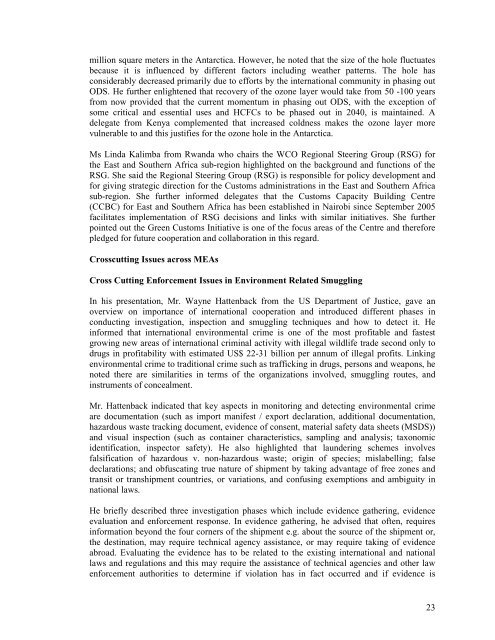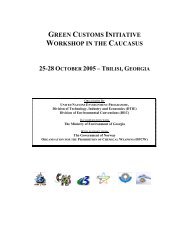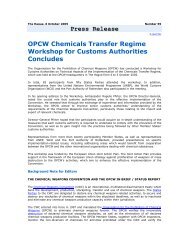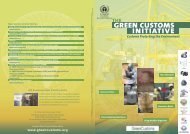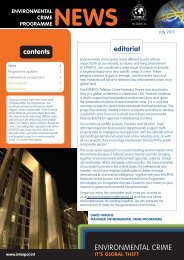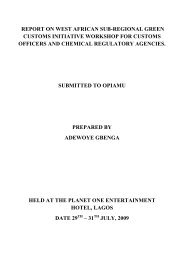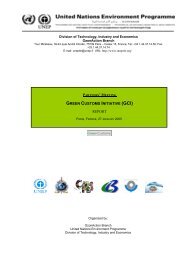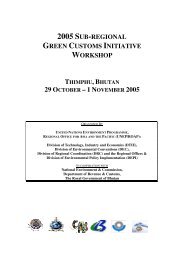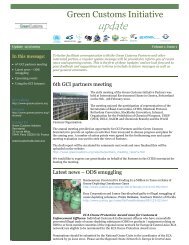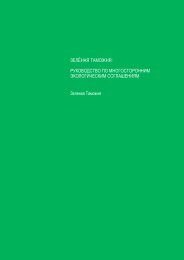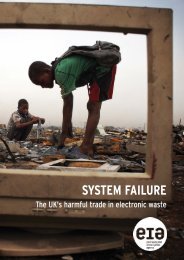Arusha - Green Customs Initiative
Arusha - Green Customs Initiative
Arusha - Green Customs Initiative
You also want an ePaper? Increase the reach of your titles
YUMPU automatically turns print PDFs into web optimized ePapers that Google loves.
million square meters in the Antarctica. However, he noted that the size of the hole fluctuates<br />
because it is influenced by different factors including weather patterns. The hole has<br />
considerably decreased primarily due to efforts by the international community in phasing out<br />
ODS. He further enlightened that recovery of the ozone layer would take from 50 -100 years<br />
from now provided that the current momentum in phasing out ODS, with the exception of<br />
some critical and essential uses and HCFCs to be phased out in 2040, is maintained. A<br />
delegate from Kenya complemented that increased coldness makes the ozone layer more<br />
vulnerable to and this justifies for the ozone hole in the Antarctica.<br />
Ms Linda Kalimba from Rwanda who chairs the WCO Regional Steering Group (RSG) for<br />
the East and Southern Africa sub-region highlighted on the background and functions of the<br />
RSG. She said the Regional Steering Group (RSG) is responsible for policy development and<br />
for giving strategic direction for the <strong>Customs</strong> administrations in the East and Southern Africa<br />
sub-region. She further informed delegates that the <strong>Customs</strong> Capacity Building Centre<br />
(CCBC) for East and Southern Africa has been established in Nairobi since September 2005<br />
facilitates implementation of RSG decisions and links with similar initiatives. She further<br />
pointed out the <strong>Green</strong> <strong>Customs</strong> <strong>Initiative</strong> is one of the focus areas of the Centre and therefore<br />
pledged for future cooperation and collaboration in this regard.<br />
Crosscutting Issues across MEAs<br />
Cross Cutting Enforcement Issues in Environment Related Smuggling<br />
In his presentation, Mr. Wayne Hattenback from the US Department of Justice, gave an<br />
overview on importance of international cooperation and introduced different phases in<br />
conducting investigation, inspection and smuggling techniques and how to detect it. He<br />
informed that international environmental crime is one of the most profitable and fastest<br />
growing new areas of international criminal activity with illegal wildlife trade second only to<br />
drugs in profitability with estimated US$ 22-31 billion per annum of illegal profits. Linking<br />
environmental crime to traditional crime such as trafficking in drugs, persons and weapons, he<br />
noted there are similarities in terms of the organizations involved, smuggling routes, and<br />
instruments of concealment.<br />
Mr. Hattenback indicated that key aspects in monitoring and detecting environmental crime<br />
are documentation (such as import manifest / export declaration, additional documentation,<br />
hazardous waste tracking document, evidence of consent, material safety data sheets (MSDS))<br />
and visual inspection (such as container characteristics, sampling and analysis; taxonomic<br />
identification, inspector safety). He also highlighted that laundering schemes involves<br />
falsification of hazardous v. non-hazardous waste; origin of species; mislabelling; false<br />
declarations; and obfuscating true nature of shipment by taking advantage of free zones and<br />
transit or transhipment countries, or variations, and confusing exemptions and ambiguity in<br />
national laws.<br />
He briefly described three investigation phases which include evidence gathering, evidence<br />
evaluation and enforcement response. In evidence gathering, he advised that often, requires<br />
information beyond the four corners of the shipment e.g. about the source of the shipment or,<br />
the destination, may require technical agency assistance, or may require taking of evidence<br />
abroad. Evaluating the evidence has to be related to the existing international and national<br />
laws and regulations and this may require the assistance of technical agencies and other law<br />
enforcement authorities to determine if violation has in fact occurred and if evidence is<br />
23


